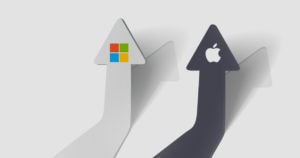At the end of November 2018, Microsoft dethroned Apple and became the world’s most valuable publicly listed company. The technology titan last held the number one spot more than 15 years ago. Friday, November 30 trading saw Microsoft’s market capitalisation surpass $851 billion (£668 billion) – $4 billion (£3.1 billion) more than Apple’s.
Add Microsoft to your portfolio
65% of retail investor accounts lose money when trading CFDs with this provider.
You should consider whether you can afford to take the high risk of losing your money.
This is not investment advice.
Microsoft is battling with Apple and Amazon for the title of the world’s most valuable publicly listed company. Bill Gates founded Microsoft back in 1975 and the company has gone from strength to strength over its 40-year history. Given Microsoft’s enduring triumph, will it outlast its two biggest rivals?
Apple made history in August by becoming the first publicly traded company in America to reach $1 trillion in market cap. Amazon hit the same milestone about a month later. In late November, Microsoft inched ahead of its rivals and is currently demonstrating incredible staying power. Indeed, the last time Microsoft was the most valuable publicly traded company was in 2002.
65% of retail investor accounts lose money when trading CFDs with this provider.
You should consider whether you can afford to take the high risk of losing your money.
This is not investment advice.
Admittedly, this recent reshuffle derived from Apple’s falling stock rather than a significant leap in value for Microsoft. The former shed close to a quarter of a trillion dollars in value, as analysts wondered whether iPhone sales had peaked.
The financial results for the fourth quarter of fiscal 2018 for Microsoft – MSFT on eToro – showed a 17 per cent revenue increase to $30.1 billion, and a 35 per cent increase in operating income to $10.4 billion.
It should be noted that Microsoft, now well into its fifth decade, has minimal geopolitical risk as compared to some other tech giants. Apple, for instance, is exposed to turbulent trade disputes and has encountered adversity for not sharing data. Microsoft’s strategy has paid off for its investors.
Microsoft’s diversity is a primary reason for its ongoing success – or more specifically, its staying power. Microsoft maintains a diverse revenue stream from hardware (Surface, Xbox), software (Windows, Office), and cloud services (Azure).
Meanwhile, Amazon relies on product sales, Apple is a hardware company at its core, and Google owners Alphabet, alongside Facebook, depend heavily on advertising sales.
Moreover, Microsoft has moved with the times. In recent years, the tech giant has led the way in new technologies such as cloud computing and research and development  (R & D) in artificial intelligence (AI).
(R & D) in artificial intelligence (AI).
Microsoft’s growth was initially slow but steady. Mr Gates’ interest in computer programming was already apparent at a young age, and he pursued his passion during his Harvard years. In 1975, together with childhood friend Paul Allen, he created a version of BASIC, the programming language for the first microcomputer, the MITS Altair 8800.
The pair approached MITS with their innovation and the organisation agreed to distribute the program as Altair BASIC. Gates and Allen officially established Microsoft thereafter in 1975. Bill Gates, who never returned to Harvard to complete his studies, was appointed Chief Executive. Microsoft gained independence from MITS the following year.
However, it wasn’t until the early 1980s, when Microsoft launched the MS-DOS operating system, that the company truly took off. The MS-DOS launch confirmed the startup as an industry pioneer. The MS-DOS design enabled its integration into different hardware, thereby reducing expenses for prospective customers.
Microsoft grew its user base after negotiating relationships with tech titans such as IBM and Intel, which in turn, persuaded its early adopters of its potential. In 1981, Microsoft underwent its first restructure, reincorporating the organisation in Washington State, and appointing Bill Gates as president and chairman of the board.
The first version of its Windows operating system was released in late 1985. Ten years later, the new Windows 95 became incredibly popular. The company went on to release Windows XP in 2001, Windows Vista in 2007, as well as Windows 7 in 2009 and Windows 8 two years later.

The company began diversifying around the year 2000, entering the games console market, which was then dominated by Sony and Nintendo. The Xbox, which was launched in 2001, disrupted the industry and led to Microsoft expanding into other areas.
In a typical display of confidence, Microsoft was not afraid to go up against Apple and the iPhone, and introduced the Windows Phone in 2011. It acquired Nokia two years later.
Since Mr Gates took a step back (although not entirely) in 2008 from steering Microsoft, the organization has continued pursuing new revenue streams.
Satya Nadella, who was named CEO in 2014, should be credited with keeping pace with change. A year after he was appointed, Mr Nadella voiced his dissatisfaction with Microsoft’s founding mission to put “a computer on every desk and in every home”, as set out by Mr Gates.
“When I joined the company in 1992, we used to talk about our mission as putting a PC in every home, and by the end of the decade we [had] done that, at least in the developed world,” Mr Nadella said in a 2015 interview.
The incumbent CEO has managed to regain a sense of purpose to drive Microsoft forward and forced it to innovate. The company’s focus has shifted from PCs and Windows software to cloud computing – such as Azure and Office 365 offerings – and a shrewd acquisition program that saw Microsoft procure the business social media platform LinkedIn for a reported $26.2 billion in 2016.
Today, according to the company’s official website, “Microsoft enables digital transformation for the era of an intelligent cloud and an intelligent edge. Its mission is to empower every person and every organisation on the planet to achieve more.”

As of December 2018, Microsoft has 134,944 employees worldwide, with almost half (44.7 per cent) in engineering, 18 per cent in worldwide commercial business, 16.5 per cent working in Global Sales Marketing & Operations, and 9.5 per cent working at LinkedIn.
Microsoft has established a winning formula and courageously enters new tech markets. Given its impressive track record of innovation and diversification, Microsoft may well remain near, or at the top, of the list of most valuable, publicly listed companies, half a century from now. No wonder it continues to appeal to our investors.
Microsoft Timeline
1975
Microsoft founded
1981
IBM introduces its personal computer with Microsoft’s 16-bit operating system, MS-DOS 1.0
1986
Microsoft stock goes public
1990
Microsoft launches Windows 3.0
1995
Microsoft launches Windows 95
2001
Microsoft launches Windows XP
Microsoft launches Xbox
2003
Microsoft launches Microsoft Office System
2005
Microsoft launches Xbox 360
2008
Bill Gates transitions from his day-to-day role at Microsoft to spend more time on his work at The Bill & Melinda Gates Foundation
2009
Microsoft launches Bing decision engine
2012
Microsoft launches Windows 8 and Microsoft Surface
Microsoft unveils Windows Phone
2013
Microsoft launches Outlook.com
Microsoft unveils Xbox One
Microsoft announces its acquisition of Nokia’s devices and services business, licensing Nokia’s patents and mapping services
2014
Satya Nadella named Chief Executive Officer
Microsoft launches Office for iPad
Microsoft completes its acquisition of Nokia Devices and Services business
Minecraft joins Microsoft
2016
Microsoft announces the formation of a new AI and Research Group
Microsoft researchers achieve human parity in conversational speech recognition
Microsoft completes its acquisition of LinkedIn
2017
Microsoft, Facebook, and Telxius complete ‘Marea’, the highest-capacity subsea cable to cross the Atlantic Ocean
Microsoft launches Xbox One
2018
Microsoft announces an agreement to acquire Github
Surface Go becomes available
eToro is a multi-asset platform which offers both investing in stocks and cryptoassets, as well as trading CFD assets.
CFDs are complex instruments and come with a high risk of losing money rapidly due to leverage. 65% of retail investor accounts lose money when trading CFDs with this provider. You should consider whether you understand how CFDs work and whether you can afford to take the high risk of losing your money.
This content is intended for information and educational purposes only and should not be considered investment advice or investment recommendation. Past performance is not an indication of future results.

